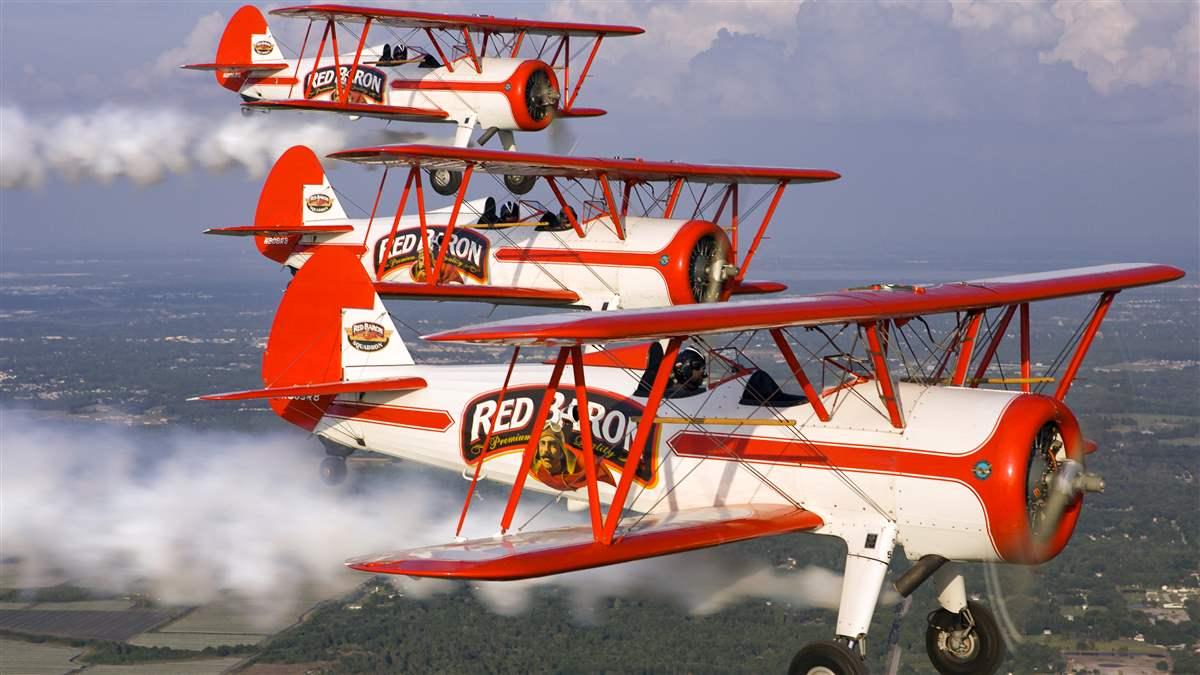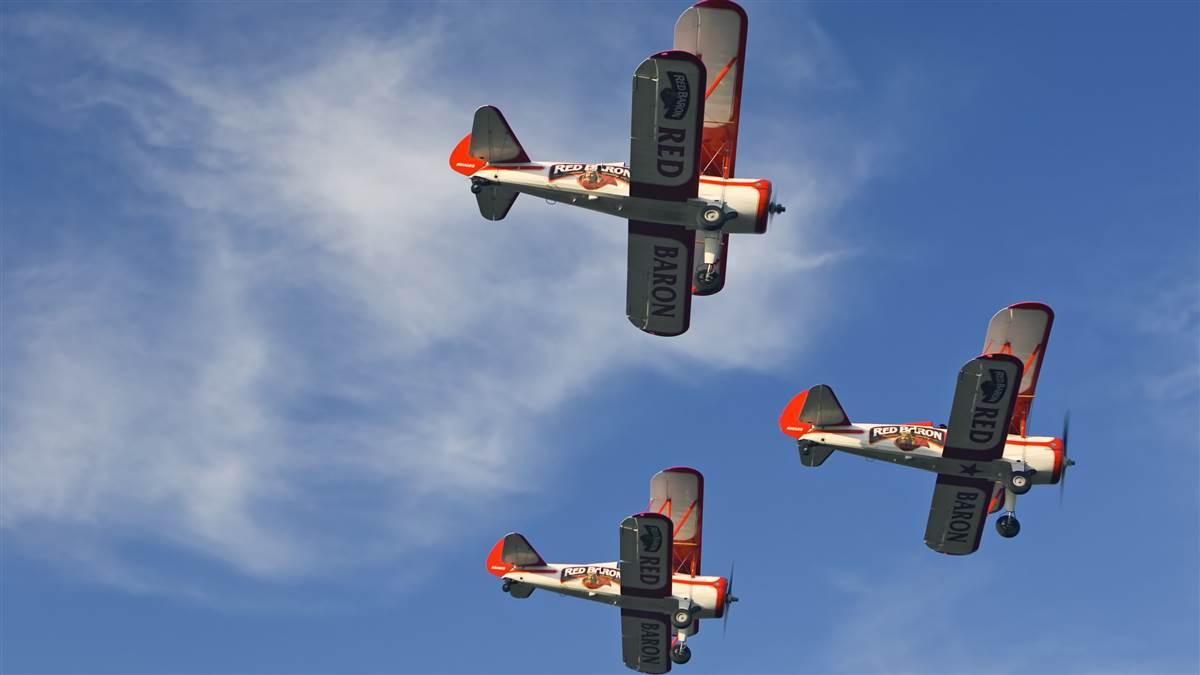Proficiency: Keeping station
A taste of one of aviation’s ultimate challenges
By Tom Lecompte
Flying from a position about 45 degrees behind and less than a wingspan away from the airplane in front of you, your world consists of nothing but your relative position to that airplane. Nothing else matters. Not the weather, the engine instruments, your airspeed, the terrain, your altitude, or even other traffic. All your experience, your skill, your focus, and your anticipation are concentrated solely on maintaining that position.

Flying formation is not for everybody. For one thing, it violates that most primary of aviation tenets: Thou shalt avoid other aircraft. For another, it requires pilots to surrender much of what it means to be pilot in command, entrusting the success of the flight, the wellbeing of one’s airplane—indeed, our very life—to another pilot.
But for some pilots, flying formation represents one of the ultimate aviation challenges. An hour of flying tight formation will leave most pilots wrung out and soaked in sweat. But it is also immensely gratifying. After flying formation, flying an ILS approach to minimums seems like a piece of cake.
 A few GA organizations allow nonprofessionals the chance to learn the art of formation flight. Some, such as the Formation and Safety Team (FAST) and Formation Flying Inc., provide standards, evaluate proficiency, and monitor currency to enable pilots to fly in airshow airspace. Others allow pilots of like aircraft to gather for mass arrivals at aviation events. Among them is the American Bonanza Society, which each year organizes the Bonanzas to Oshkosh (B2Osh) fly-in to EAA AirVenture in Oshkosh. A handful of other owners’ associations do the same: Globe Swift, Mooney, Cirrus, and Van’s, to name a few. But the B2Osh group is by far the oldest and largest.
A few GA organizations allow nonprofessionals the chance to learn the art of formation flight. Some, such as the Formation and Safety Team (FAST) and Formation Flying Inc., provide standards, evaluate proficiency, and monitor currency to enable pilots to fly in airshow airspace. Others allow pilots of like aircraft to gather for mass arrivals at aviation events. Among them is the American Bonanza Society, which each year organizes the Bonanzas to Oshkosh (B2Osh) fly-in to EAA AirVenture in Oshkosh. A handful of other owners’ associations do the same: Globe Swift, Mooney, Cirrus, and Van’s, to name a few. But the B2Osh group is by far the oldest and largest.
The tradition started in 1990 when Wayne Collins and a few friends decided the only way to ensure they could camp together at Oshkosh was to arrive together in formation. It has since evolved into an annual event that includes more than 100 aircraft. In the weeks leading up to AirVenture, the B2Osh organization hosts a series of weekend clinics around the country to teach the fundamentals of formation in preparation for the mass arrival.
Do you have what it takes?
Although the clinics are primarily intended for participants in the mass arrival, pilots of similar-performing aircraft are welcome to attend. Still, my Piper Comanche looked a bit out of place on a ramp full of Bonanzas.
“We have to get you a real airplane,” joked Paul Safran, leader of the Northeast formation clinic out of Barnes Municipal Field (BAF) in Westfield, Massachusetts. I was one of four newbies attending the clinic. The rest—all Bonanza drivers—had prior experience and were there to brush up.
 After riding along as an observer, I wasn’t sure I had what it takes to fly formation. From the ground it all looks very smooth and precise. In the air the constant jostling, the sawing of the throttle, the changes in pitch and yaw, and the overwhelming sense of mortality flying so close to another aircraft made me wonder if this was really such a good idea. (How close do they fly, you ask? Close enough so that if the lead pilot sneezed, you’d say, “God bless you.”)
After riding along as an observer, I wasn’t sure I had what it takes to fly formation. From the ground it all looks very smooth and precise. In the air the constant jostling, the sawing of the throttle, the changes in pitch and yaw, and the overwhelming sense of mortality flying so close to another aircraft made me wonder if this was really such a good idea. (How close do they fly, you ask? Close enough so that if the lead pilot sneezed, you’d say, “God bless you.”)
As I prepared for my first flight piloting my airplane just a few feet from another aircraft, I was more nervous than I had been since my first solo flight 30 years ago.
How close do they fly, you ask? Close enough so that if the lead pilot sneezed, you’d say, “God bless you.”My mentor, Robert Mark, must have recognized the look on my face. Some pilots can’t do it, he told me. They simply don’t have the skills—or worse, they freeze up. He remembered the first time he tried flying formation in 1994. “I thought these guys were nuts, that they were suicidal,” he said. But he decided to give it another try and now, 20 years and more than 1,000 hours of formation flying later, he’s become one of B2Osh’s most experienced pilots. He’s also a card-carrying member of Formation Flying Inc., an FAA-sanctioned organization that evaluates pilots, which allows them to fly at airshows.
Another veteran formation pilot, Joe Fischetti, a civil engineer and former charter pilot, said of formation flying: “I find it relaxing. Everything else just tunes out, and you’re totally in the moment. It’s beautiful.”
Formation 101
In a conference room inside the airport’s FBO, clinic leader Paul Safran laid out the basics of flying formation to the group.
Like aerobatics, he said, formation flying demands a pilot’s utmost attention and skill. Flying formation, however, “requires a completely different skill set from any other type of flying.” The most important skill is the ability to recognize and control the relative motion between aircraft.
Safety is maintained by creating a “box” of space around each aircraft so there’s no overlap between airplanes. One airplane’s spinner ends at another airplane’s tail cone. Wing tips don’t overlap, and the trailing aircraft is stepped down at least the height of its vertical stabilizer. Safran used a pair of toy airplanes attached to sticks to demonstrate the relative positions of the airplanes in various maneuvers. We learned some new terms, such as getting “sucked” (falling behind), or going “acute” (overtaking the lead aircraft), and about having enough “smash” (reserve power).
Hand signals, not radio calls, are used to communicate between aircraft—the same system World War II aviators used to cross safely into Axis territory. While partly a tribute to formation flying’s military origins, hand signals improve safety. To jam the airwaves with a welter of radio calls would invite chaos. As a backup, pilots monitor a preselected radio frequency, such as “fingers,” 123.45, or “cheap suit,” 129.95. But “the only thing we want to hear over the radio while in formation,” said Mark, is, “Lead, you’re on fire!”
A flight of two aircraft is the basic building block of formation flying. A leader and wingman comprise each section or element, and larger formations are built using multiple elements; the most common is a division, a flight of four aircraft consisting of two elements. A flight with an odd number of aircraft still incorporates elements, but one airplane is considered an element without a wingman.
Safran broke down the various control inputs within each maneuver. Lateral movements are made not with aileron, but with a combination of aileron and rudder, mostly rudder—cross-controlling to make the aircraft slide in one direction or the other. Throttle is used to control relative motion forward and backward, pitch for movement up and down—but bear in mind that every change in pitch requires a corresponding change in throttle to maintain speed. In turns, the airplane on wing will need to adjust both pitch and throttle to maintain position and compensate for the differing radii of each aircraft’s turns.
It takes time and practice to develop the necessary touch and anticipation to be smooth, Safran said. As newbies, we should expect to make many, and sometimes very abrupt, changes in pitch and power. “You will hear your gear horn go off,” he warned.
I was paired with Doug Wohl, a Cirrus owner based on Long Island. As with all formation flights, we briefed first. This was a basic flight, with an element takeoff (side by side), climbout, turns in both directions, a cross-under, and then return to the field for an element landing. Every component of the flight, from start-up and taxi to landing and shutdown, was discussed in advance. Nothing was left to improvisation. Before starting we checked out each other’s aircraft, looking at the sightlines we’d use while airborne to align ourselves.
Was Wohl as nervous as I was? He didn’t show it.
At exactly 2:05 p.m., we started up. Lined up on the runway, Wohl signaled for the power-up by waving his index finger in a circular motion. I waited for his head nod to release my brakes and gradually increase to takeoff power, careful to maintain alignment with the Cirrus. As planned, our airplanes lifted off the runway in unison.
Trying to maintain position behind the Cirrus, however, I quickly realized that flying formation is less about maintaining position than the constant work required getting back into position. My throttle went stop to stop. My gear horn was howling. I did get sucked. I did go acute. And by the end I was soaked in sweat. But as the flight progressed, things smoothed out a bit. I began to anticipate things a little better and the errors became less startling. By the time I shut down, I had the feeling that I was actually beginning to “get it,” and with it came a feeling of both exhaustion and accomplishment.
Afterward, Mark shook my hand with a look that said, “See, I told you so,” and added, “There are times I’m so in the moment that feel like I’m almost controlling the airplane in front of me.”
OK, give me another 20 years.
Tom LeCompte is a freelance writer and instrument-rated private pilot. He owns a Piper PA–24.
